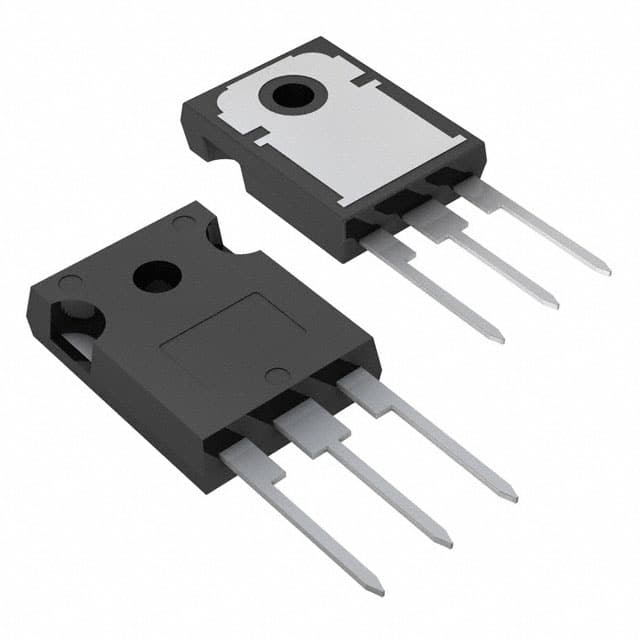Lihat spesifikasi untuk detail produk.

TIP142 Transistor: Encyclopedia Entry
Introduction
The TIP142 is a high-power NPN transistor that belongs to the category of power transistors. It is commonly used in electronic circuits where high voltage and current amplification are required. This entry provides an overview of the TIP142 transistor, including its basic information, specifications, pin configuration, functional features, advantages and disadvantages, working principles, application field plans, and alternative models.
Basic Information Overview
- Category: Power Transistor
- Use: High-voltage and high-current amplification in electronic circuits
- Characteristics: High power dissipation, high gain, and low saturation voltage
- Package: TO-218
- Essence: Silicon NPN Darlington Transistor
- Packaging/Quantity: Typically available in packs of 10 or 25 units
Specifications
- Collector-Emitter Voltage (VCEO): 100V
- Collector-Base Voltage (VCBO): 100V
- Emitter-Base Voltage (VEBO): 5V
- Collector Current (IC): 10A
- Power Dissipation (PD): 125W
- Gain (hFE): 1000 (min)
Detailed Pin Configuration
The TIP142 transistor has a standard TO-218 package with three pins: 1. Base (B): Input terminal for controlling the flow of current 2. Collector (C): Output terminal for the amplified current 3. Emitter (E): Ground terminal for the transistor
Functional Features
- High power dissipation capability
- High current gain
- Low saturation voltage
- Built-in protection diodes for inductive loads
Advantages and Disadvantages
Advantages
- Suitable for high-power applications
- Low saturation voltage reduces power loss
- Built-in protection diodes enhance reliability in inductive load applications
Disadvantages
- Relatively large package size
- Higher cost compared to smaller transistors with similar characteristics
Working Principles
The TIP142 operates based on the principles of bipolar junction transistors. When a small current flows into the base terminal, it controls a much larger current flowing between the collector and emitter terminals. This allows the transistor to amplify signals and control high-power loads in electronic circuits.
Detailed Application Field Plans
The TIP142 transistor finds extensive use in various high-power electronic applications, including: - Audio amplifiers - Power supply circuits - Motor control systems - High-power LED drivers - Switching regulators
Detailed and Complete Alternative Models
Some alternative models to the TIP142 transistor include: - TIP147 - MJ11015 - MJL21193 - 2N6059
In conclusion, the TIP142 transistor is a versatile component that is widely used in high-power electronic circuits due to its high voltage and current amplification capabilities, making it an essential part of many electronic designs.
Word Count: 410
Sebutkan 10 pertanyaan dan jawaban umum terkait penerapan TIP142 dalam solusi teknis
Sure, here are 10 common questions and answers related to the application of TIP142 in technical solutions:
What is TIP142?
- TIP142 is a high power NPN Darlington transistor designed for general-purpose amplifier and low frequency switching applications.
What is the maximum collector current of TIP142?
- The maximum collector current of TIP142 is 10A.
What is the maximum collector-emitter voltage of TIP142?
- The maximum collector-emitter voltage of TIP142 is 100V.
What are the typical applications of TIP142?
- TIP142 is commonly used in audio amplifiers, power supply regulators, and industrial control systems.
How should TIP142 be mounted for optimal performance?
- TIP142 should be mounted on a heat sink to dissipate heat and ensure proper operation.
What are the key characteristics of TIP142?
- Some key characteristics of TIP142 include high DC current gain, low saturation voltage, and high transition frequency.
Can TIP142 be used for high power applications?
- Yes, TIP142 is suitable for high power applications due to its high collector current rating.
What precautions should be taken when using TIP142 in circuits?
- Precautions such as proper heat sinking, avoiding overvoltage conditions, and ensuring proper biasing should be taken when using TIP142 in circuits.
Is TIP142 suitable for use in automotive applications?
- Yes, TIP142 can be used in automotive applications such as motor control and power management.
Where can I find the detailed datasheet for TIP142?
- The detailed datasheet for TIP142 can be found on the manufacturer's website or through authorized distributors.
I hope these questions and answers provide helpful information about the application of TIP142 in technical solutions. Let me know if you need further assistance!

